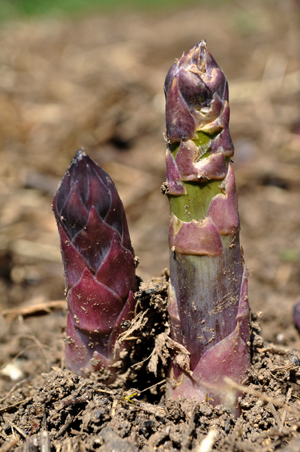 The day I visited Barb Dietrich at Oley Valley Organics a few weeks ago, it was still pretty chilly. That was probably a good thing because had I waited to schedule our little chat, chances are she’d be knee-high in asparagus weeding, harvesting, or both, right now!
The day I visited Barb Dietrich at Oley Valley Organics a few weeks ago, it was still pretty chilly. That was probably a good thing because had I waited to schedule our little chat, chances are she’d be knee-high in asparagus weeding, harvesting, or both, right now!
To maintain a certified organic farm takes dedication, to say the least.
We know, here at our place, the level of work involved to combat weeds without the use of chemicals.
Yet to be a certified organic farm goes beyond that. It means you’re pledging your practices for the safe maintenance of the environment that surrounds you. And maybe, like the Dietrichs, you’ve also taken extra steps toward recovering an area (be sure to watch our webisode about Oley Valley Organics to see what I mean by “recovery”).
Finalizing the paperwork for our farm purchase in 2004 meant sitting in the realtor’s office with the former owners as we exchanged signatures. I remember a particularly somber moment for them when the place officially became “ours.”
There was a pause…and then I believe I thanked the former owner…he looked up, smiled, and said: “I believe we never truly ‘own’ a place…we’re merely the keepers for a while”.
Here’s to all of those who “keep” healthy farms.

 Forget your daffodils and tulips! The real harbinger of spring in these parts? Skunk cabbage.
Forget your daffodils and tulips! The real harbinger of spring in these parts? Skunk cabbage. The rhizomes (horizontal underground stems) that anchor this plant can live thousands of years, according to botanists, and no matter where you find eastern skunk cabbage (from Canada all the way to Georgia) the species is the same—meaning it hasn’t adapted to different zones. All it requires are damp/boggy areas which remain wet year-round.
The rhizomes (horizontal underground stems) that anchor this plant can live thousands of years, according to botanists, and no matter where you find eastern skunk cabbage (from Canada all the way to Georgia) the species is the same—meaning it hasn’t adapted to different zones. All it requires are damp/boggy areas which remain wet year-round. Skunk cabbage has been around for thousands of years—a native wetlands plant. It intrigues everyone from the weekend hiker to the learned botanist. Me? I just like to be reminded spring is right around the corner.
Skunk cabbage has been around for thousands of years—a native wetlands plant. It intrigues everyone from the weekend hiker to the learned botanist. Me? I just like to be reminded spring is right around the corner. The day I visited Barb Dietrich at Oley Valley Organics a few weeks ago, it was still pretty chilly. That was probably a good thing because had I waited to schedule our little chat, chances are she’d be knee-high in asparagus weeding, harvesting, or both, right now!
The day I visited Barb Dietrich at Oley Valley Organics a few weeks ago, it was still pretty chilly. That was probably a good thing because had I waited to schedule our little chat, chances are she’d be knee-high in asparagus weeding, harvesting, or both, right now!



